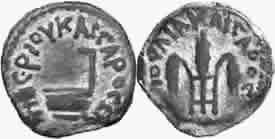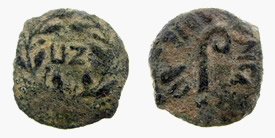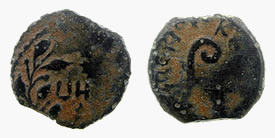I don't know; perhaps because Roman Historians dated his reign as co-equal with Augustus in AD 13?
- "The powers held by Tiberius were made equal, rather than second, to Augustus's own powers, he was for all intents and purposes a "co-princeps" with Augustus." - ibid. (same Wikipedia article)
Add to that Suetonius tells us that the declaration of his co-princeps took place in AD 12, after his return from Germania. If Luke was truly a Greek that hailed from Antioch, as many scholars claim, do you have special evidence from Syria of when they officially proclaimed the start of his reign? I'm sure most in the Empire considered it important that someone who was healthy nd powerful was really running the show. But hey, I'm only asking questions because I think it's important not to dismiss possibilities due to entrenched opinions. That hasn't served us well in the past so not willing to cast it off as a red herring.
The title of Roman Emperor was not an official one. It was informal as the Principate was masquerading as the Republic restored.
Strictly speaking, it means who holds Imperium; a Roman concept slightly difficult to translate. Basically it is the civil and military authority or sphere of control of an individual. An Emperor was declared in later times when the Legions hailed someone as Imperator, here meaning roughly 'general', and hence Imperator (Emperor) became the catch-all term. The Emperor had a collection of official titles like Pontifex Maximus, Tribunician powers, Proconsular Authority for certain provinces, Consular authority in Rome itself, Censor etc., but there was no official title 'Emperor'; even the honourific Princeps was ambigious. This is all part of Augustus' excellent system of control, while appearing to restore.
As such, there is no such thing as an official time a 'reign' started. Augustus had the Senate vote Tiberius proconsular authority for Imperial provinces and make him co-censor as part of marking him as heir-apparent, but he did not pass on the Pontifex Maximus title nor the full tribunician authority. Tiberius still only held the temporary Tribunician powers required for the Germanic campaigns, not the full panoply of Augustus'. Tiberius was very much still the junior, was not hailed by the Legions, nor held the full powers of Augustus. It is modern farce to call him 'co-princeps', for even Suetonius doesn't see it this way. This merely illustrates how untrustworthy wikipedia really is.
Anyway, Rome dated by the consuls for the year - for instance 59 BC was 'the year of the consulship of Caesar and Bibulus' (or 'the year of the consulship of Julius and Caesar' to the satirists as Bibulus was ineffective). Alternately they used 'abs Urbs condita' - from the founding of the city of Rome.
Recording the starting years of Emperor's reigns really didn't matter to them and Tiberius really didn't want to be Emperor at all.
Tiberius had withdrawn to Rhodes and stayed out of Imperial affairs until forced back by Augustus after his heirs became thin on the ground. After he became Emperor, he would withdraw to Capri and left the role as ruler largely in his prefects' hands, Sejanus then Macro. This is really not a man who would out of pride antedate his rule, even if the Romans did such a thing (which they really didn't).
Dating from Emperor's reigns was not common practice in the Principate. It only came into prominence in the Diocletianic reforms. Most areas used local dating systems. For instance, Palmyra used a calender that took Pompey's eastern conquests as a starting point. Greeks tended to date by the Olympiads. It really was not uniform nor did the Romans have official reign dates.
To people in the Eastern part of the Empire, it would be inconceivable to say anyone but Augustus ruled in 13 AD, especcially as they would not have understood Roman titulature at this time. Often Augustus was adressed as Basileus or King by embassies, which was quite impolitic and sometime problematic in Roman politics. For these reasons, a dating of Tiberius' reign from a period while Augustus was alive is highly improbable.
The fact is that Luke uses various local figures such as the Judaean Prefect and Tetrarchs to give as accurate a date as possible and mentions the year of Tiberius' reign so that it can be easily grasped, in the local calender, when this occurred. Whenever a new Emperor came along, the various client kings and cities in the Empire would usually send salutations and renew solemn oaths to Rome. This allows a fairly good reference for his readers.



